How to Storyboard for a Manga
- Understanding Manga Storytelling Techniques
- How to Boords in Manga Storyboarding
- Step-by-Step Guide to Creating a Manga Storyboard Using Boords
- Practical Tips and Best Practices
- Common Challenges in Manga Storyboarding
- Conclusion
Introduction to Manga Storyboarding
Storyboarding is a crucial step in bringing a manga story to life, whether in print or on-screen. Also known as "manga e-conte" in Japan, it outlines the story's events through drawings, serving as a visual guide for the final product, be it a comic or animated series.
Storyboarding is pivotal in animation and filmmaking, aiding creators in visualizing scenes, planning camera angles, and experimenting with ideas. In manga, this role becomes more significant due to unique storytelling techniques and visual language.
Manga, distinct from western comics and films, employs symbols and flexible panel arrangements to convey emotions and reflect the dynamic nature of the story. Understanding these aspects is crucial when creating a manga storyboard, influencing how the story is perceived by the audience.
In the following sections, we'll delve deeper into manga storytelling techniques, providing a step-by-step guide on creating a manga storyboard.
Understanding Manga Storytelling Techniques
Manga, a traditional Japanese art form, has a unique storytelling approach that sets it apart from other comic styles. To effectively storyboard for manga, you need to understand these techniques and incorporate them into your storyboard. Here are some of the key elements that define manga storytelling:
Panel Layout
Manga often uses a diverse and flexible panel arrangement, unlike the rigid grid structure commonly seen in western comics. The layout of the panels can be used to manipulate the pace of the story. For instance, a sequence of small, narrow panels can indicate a fast-paced action scene, while larger, wider panels can slow down the pace, allowing for more detailed artwork or dialogue. When storyboarding, think about how you can use the panel layout to enhance the story's mood and rhythm.
Visual Symbols
Manga is renowned for its use of visual symbols to express characters' emotions and states of mind. For instance, a character with a vein popping on their forehead indicates anger, while flowers in the background often symbolize romance or beauty. These symbols can add depth to your characters and make them more relatable to the readers. As you storyboard, consider how you can incorporate these visual cues to convey your characters' feelings effectively.
Screen Direction
In manga, the action typically flows from right to left, which is the opposite of western comics. This is an essential factor to consider when planning your storyboard, as it affects how the readers navigate the panels and interpret the story. Make sure your characters and actions follow this right-to-left direction to maintain consistency and avoid confusion.
Dramatic Framing
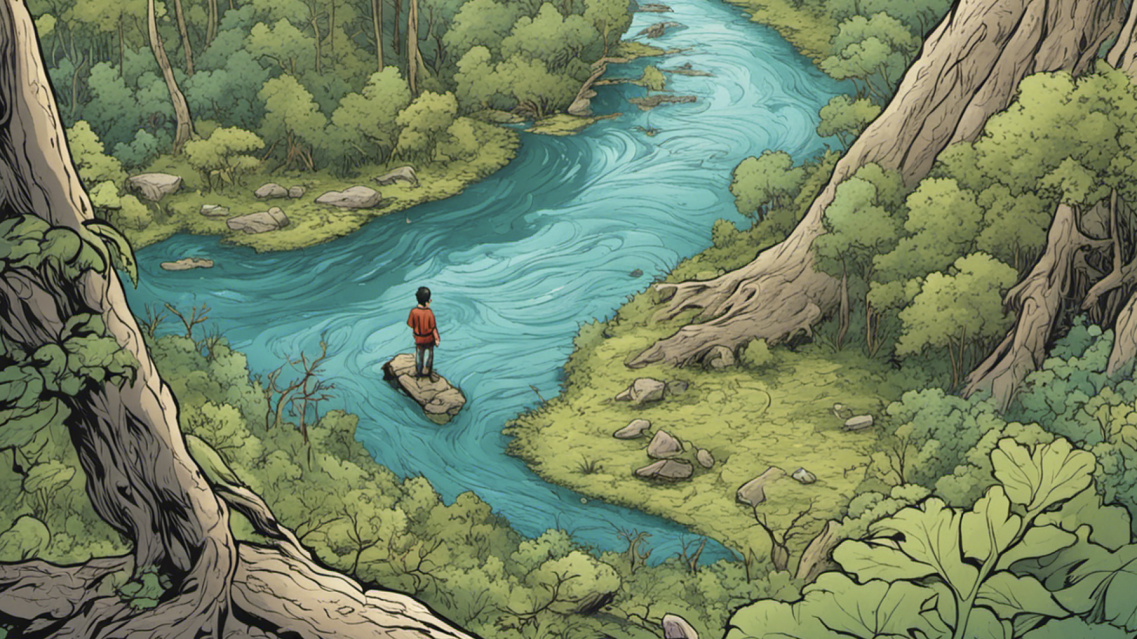
Manga often uses dramatic framing techniques, such as close-ups and unusual angles, to emphasize important moments or create tension. For example, a close-up of a character's eyes can reveal their emotions, while a bird's-eye view can provide a broader perspective of the scene. When sketching your storyboard, experiment with different camera angles and framings to enhance the visual drama of your story.
Sequential Art
Manga is a form of sequential art, which means it tells a story through a series of images. The key to successful sequential storytelling is to ensure each panel logically leads to the next, creating a smooth narrative flow. When creating your storyboard, carefully plan the sequence of events and make sure there's a clear progression from one panel to another.
By understanding and applying these manga storytelling techniques, you can create a more authentic and engaging manga storyboard. In the next section, we'll discuss how Boords, an online storyboard software, can assist in this process.
Understanding the Role of Boords in Manga Storyboarding
Boords is an online storyboard software that provides a comprehensive platform for creating and refining manga storyboards. It provides a range of tools and features designed to streamline the storyboarding process, making it an invaluable resource for manga artists of all levels.
One of the key features of Boords is its vast array of storyboard templates. These templates cater to a variety of styles and genres, allowing you to choose the one that best fits your manga story. Whether you're creating a high-paced action manga or a slow-burning romance, Boords has a template that can help you visualize your story effectively. Boords also offers tools for indicating camera movements and transitions.
In manga, the camera angle can dramatically affect how a scene is perceived by the readers. With Boords, you can easily indicate camera movements like zooms, pans, and tilts, helping you to plan your scenes more precisely. Similarly, the software allows you to indicate scene transitions, such as cuts or fades, which can help you to create a smoother narrative flow.
Collaboration is another area where Boords shines. The Commenting & Feedback feature of Boords allows users to comment directly on individual frames, simplifying the process of responding to feedback and managing tasks efficiently.
The software allows multiple users to work on a storyboard simultaneously, making it an excellent tool for manga teams. You can share your storyboard with others, receive real-time feedback, and make changes instantly. This feature can significantly speed up the revision process and ensure that everyone on the team is on the same page.
In addition to these features, Boords also provides options for exporting your storyboard in various formats. This allows you to present your storyboard professionally, whether you're pitching your manga to a publisher or sharing it with your audience.
In the following section, we'll provide a step-by-step guide on how to use these features to create your own manga storyboard.
Step-by-Step Guide to Creating a Manga Storyboard Using Boords
Creating a manga storyboard using Boords involves several steps. This guide will take you through each step in detail, providing practical tips and examples along the way.
Step 1: Understanding the Script
Before you start sketching, it's crucial to have a thorough understanding of your manga script. Read the script multiple times to identify the key scenes, characters, and emotions. Note down the important moments that need to be highlighted in the storyboard. Understanding your script will help you visualize the story and plan your storyboard effectively.
Step 2: Choosing the Right Template
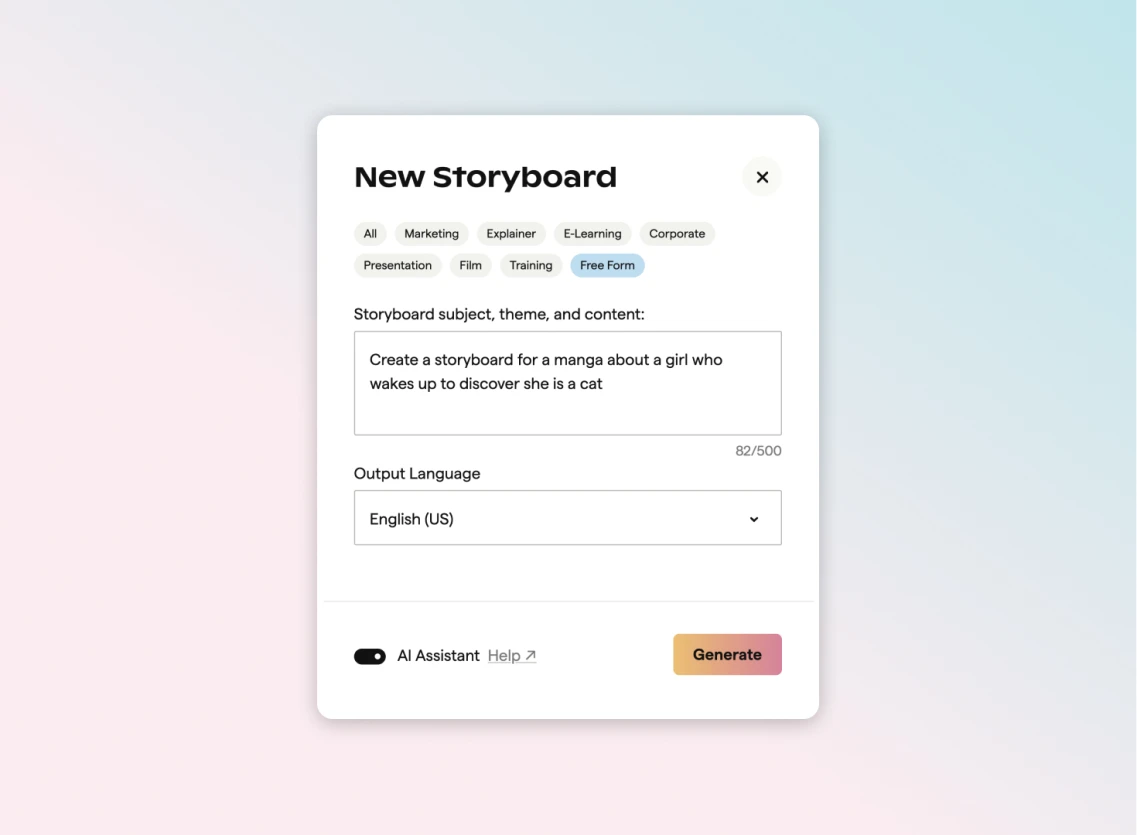
Boords offers a range of storyboard templates to cater to different styles and genres. Browse through these templates and choose the one that best fits your manga story. For instance, if you're creating an action-packed manga, you might want to choose a template with a dynamic panel layout. On the other hand, a romance manga might benefit from a template with larger panels for detailed artwork and dialogue.
Step 3: Sketching the Scenes
Now it's time to start sketching your scenes. Using Boords, you can create thumbnails of your scenes, allowing you to experiment with different ideas and make quick changes. Start with rough sketches and gradually refine them as you progress. Remember to consider the unique storytelling techniques of manga, such as the right-to-left screen direction and the use of visual symbols.
Step 4: Adding Annotations
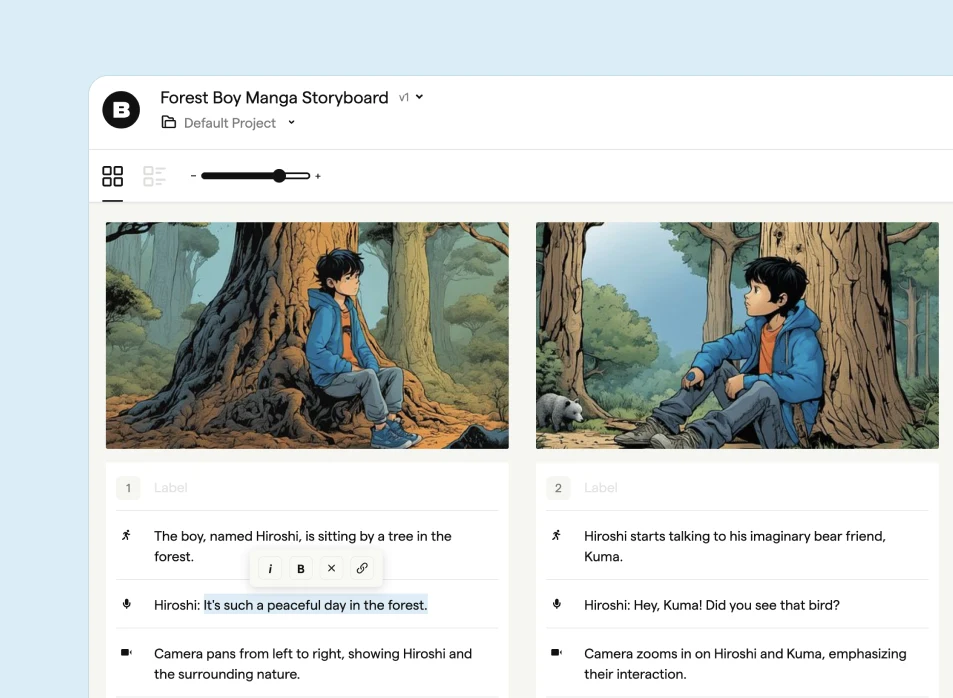
Boords allows you to add annotations to your storyboard, indicating camera movements, scene transitions, and character emotions. This can help you plan your scenes more precisely and create a smoother narrative flow. For instance, you can use annotations to indicate a camera zoom on a character's face to reveal their emotions, or a scene transition from one location to another.
Step 5: Collaborating and Refining the Storyboard
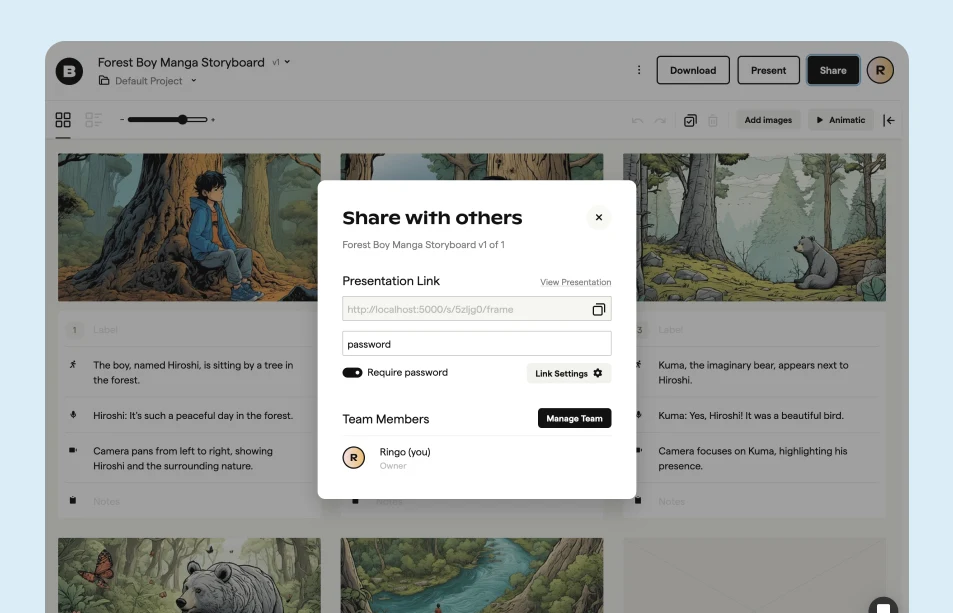
Boords' collaboration features allow you to share your storyboard with others and receive real-time feedback. This can be especially useful if you're working in a team. You can make changes instantly based on the feedback, ensuring that everyone is on the same page. Boords also offers version tracking, allowing you to review the changes and make necessary adjustments.
Step 6: Exporting the Final Storyboard
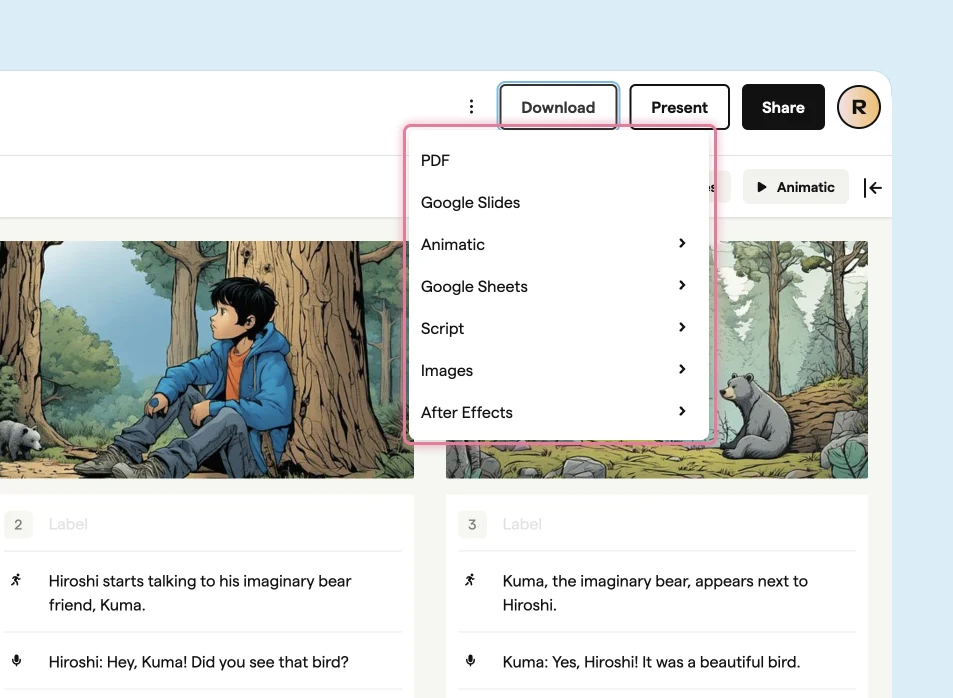
Once you're satisfied with your storyboard, you can use Boords to export it in various formats, such as PDF or MP4. This allows you to present your storyboard professionally, whether you're pitching your manga to a publisher or sharing it with your audience.
Step 7: Reviewing and Revising the Storyboard
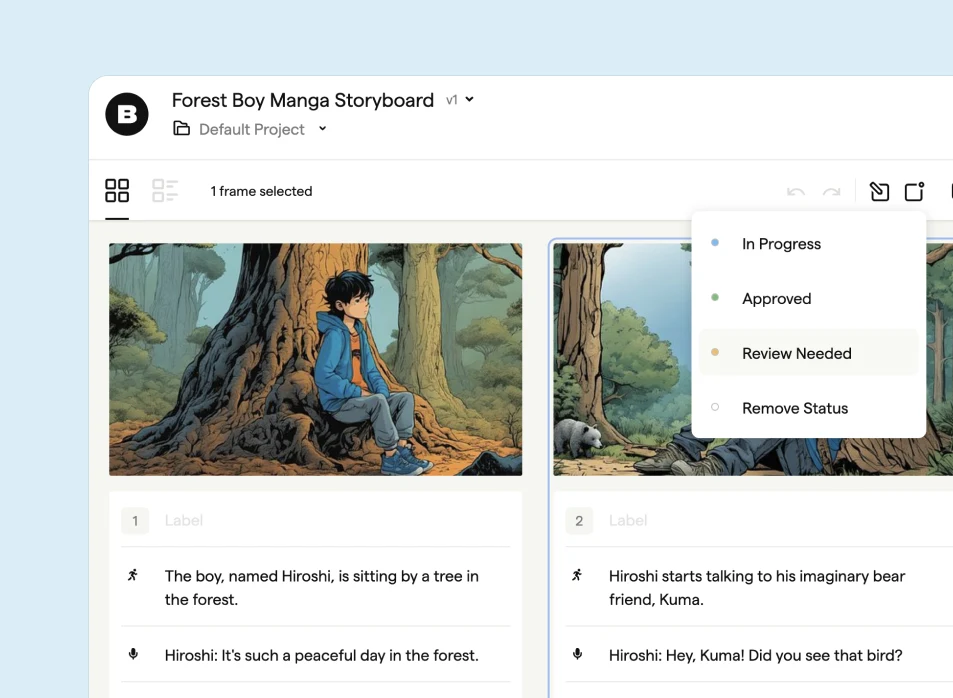
Finally, always take the time to review and revise your storyboard. Look for any inconsistencies or errors, and consider how you can improve the pacing, camera angles, and visual drama. Don't be afraid to make changes – the goal is to create the best possible visual guide for your manga story.
Practical Tips and Best Practices for Manga Storyboarding
Creating a manga storyboard can be a challenging yet rewarding process. Here are some practical tips and best practices to help you create an engaging and effective storyboard for your manga story:
1. Maintain the Pacing
The pacing of your manga is crucial in keeping your readers engaged. Use your storyboard to plan the pace of your story. Remember, a sequence of smaller, narrower panels can create a sense of fast-paced action, while larger panels can slow down the story, allowing for more detailed artwork or dialogue. Vary the size and number of panels to create a rhythm that matches the mood and tempo of your story.
2. Choose the Right Camera Angles
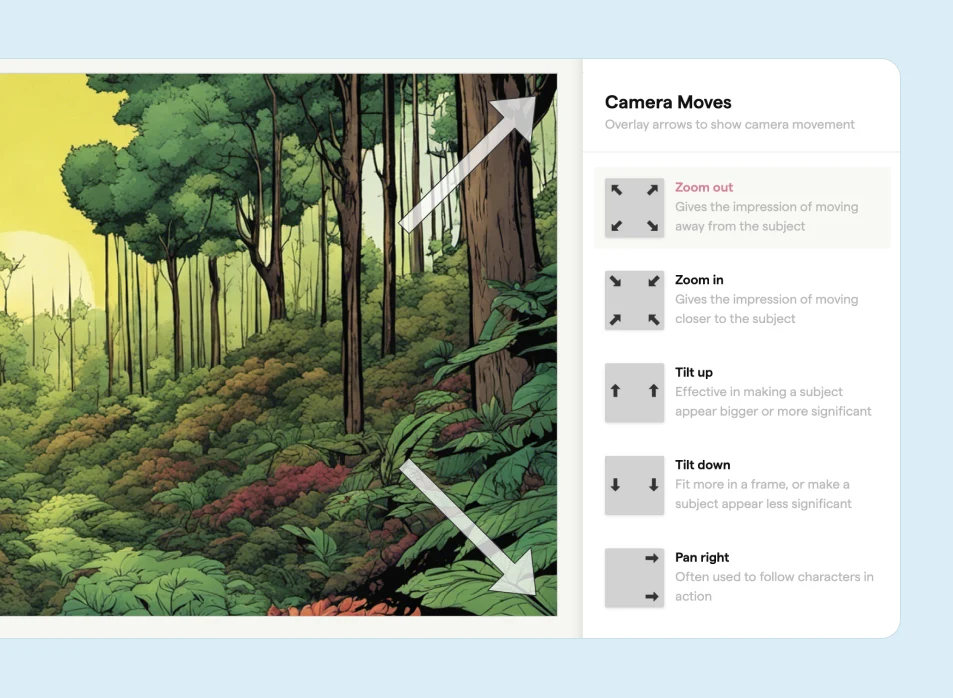
Camera angles can dramatically affect how a scene is perceived by the readers. Use your storyboard to experiment with different camera angles. For instance, a close-up can reveal the emotions of a character, while a bird's-eye view can provide a broader perspective of the scene. Don't be afraid to use dramatic angles and framings to highlight important moments or create tension.
3. Create Dynamic Scenes
Manga is known for its dynamic and fluid storytelling. Use your storyboard to plan dynamic scenes that captivate your readers. This could mean using diagonal lines to suggest movement, adding depth with perspective drawings, or using visual symbols to express characters' emotions. Remember, a well-planned dynamic scene can make your manga more engaging and visually interesting.
4. Consistency is Key
Consistency in character design and style is crucial in manga. Use your storyboard as a reference to maintain consistency throughout your story. This includes consistency in character expressions, costumes, and settings. Remember, inconsistencies can distract your readers and disrupt the flow of your story.
5. Use Boords to Its Full Potential
Boords is a powerful tool for manga storyboarding. Make the most of its features to streamline your storyboarding process. Use the templates, add annotations for camera movements and scene transitions, collaborate with your team, and export your storyboard in various formats. Remember, a well-planned storyboard can save you time and effort in the long run.
Overcoming Common Challenges in Manga Storyboarding
Creating a manga storyboard can pose several challenges, especially if you're new to this art form. Let's discuss some of these common hurdles and how you can overcome them using Boords.
Challenge 1: Maintaining Consistency in Character Expressions
Consistency in character expressions is crucial to maintain the authenticity of your manga. However, it can be challenging to keep the expressions consistent across different panels, especially when the characters are experiencing a range of emotions.
Challenge 2: Visualizing Complex Scenes
Sometimes your manga script may call for complex scenes, such as large crowd scenes or intricate action sequences. Visualizing these scenes in a storyboard can be tricky, as you need to balance detail with readability.
Challenge 3: Collaborating with a Team
If you're working with a team, collaborating on a manga storyboard can be a challenge. You need to ensure everyone is on the same page and that changes are communicated effectively.
Solution: Boords' collaboration features can make this process smoother. You can invite your team members to view and edit the storyboard, ensuring everyone has access to the latest version. The software also offers real-time feedback and version tracking, allowing you to keep track of changes and make sure everyone's input is considered.
Conclusion
Creating an effective manga storyboard is a crucial step in bringing your vision to life. As discussed in this guide, storyboarding allows you to plan the visual narrative, experiment with storytelling techniques, and collaborate with your team. By following the step-by-step process outlined here, you can create an engaging storyboard that captures the essence of your manga.
The key points to remember are:
- Understand the unique storytelling conventions in manga, such as panel layouts, visual symbols, and right-to-left flow. Incorporate these techniques into your storyboard.
- Choose the right template on Boords to match your manga genre and style. The templates can help you structure your narrative effectively.
- Sketch rough panels first, then refine with details. Annotate your panels to indicate camera angles, transitions, etc.
- Collaborate with others and refine the storyboard based on feedback. Boords' features facilitate efficient collaboration.
- Review, revise and export your final storyboard for pitching or sharing purposes.
With the right planning and preparation, you can create a manga storyboard that brings your creative vision to life.